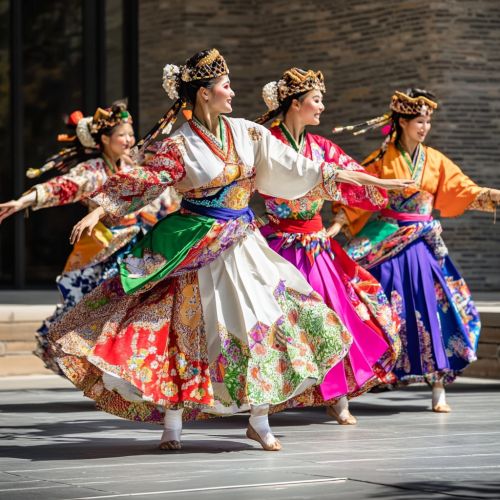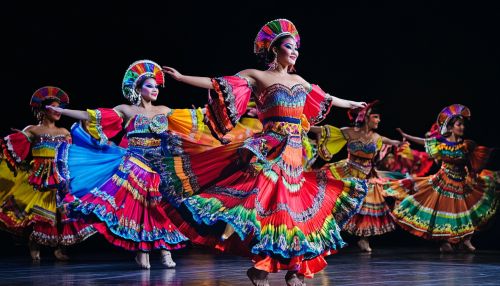Sega (music): Difference between revisions
(Created page with "== History and Origins == Sega music, also known as Sega, is a genre of music that originated in the Indian Ocean islands, particularly Mauritius, Réunion, and the Seychelles. The genre has its roots in the 18th century, during the period of slavery, and is deeply intertwined with the cultural and social history of these islands. Sega music was initially a form of expression for enslaved Africans who were brought to these islands by European colonizers. It served as a m...") |
No edit summary |
||
| Line 61: | Line 61: | ||
* [[Intangible cultural heritage]] | * [[Intangible cultural heritage]] | ||
[[Image:Detail-97889.jpg|thumb|center|Traditional Sega dance performance with dancers in colorful costumes.|class=only_on_mobile]] | |||
[[Image:Detail-97890.jpg|thumb|center|Traditional Sega dance performance with dancers in colorful costumes.|class=only_on_desktop]] | |||
== References == | == References == | ||
Latest revision as of 17:55, 4 September 2024
History and Origins
Sega music, also known as Sega, is a genre of music that originated in the Indian Ocean islands, particularly Mauritius, Réunion, and the Seychelles. The genre has its roots in the 18th century, during the period of slavery, and is deeply intertwined with the cultural and social history of these islands. Sega music was initially a form of expression for enslaved Africans who were brought to these islands by European colonizers. It served as a medium to convey their pain, suffering, and hopes for freedom.
The early forms of Sega were heavily influenced by African rhythms and melodies, combined with the musical traditions of the European settlers. Over time, Sega evolved to incorporate elements from other cultures, including Indian, Chinese, and Malagasy influences, reflecting the diverse demographic composition of the islands.
Musical Characteristics
Sega music is characterized by its distinctive rhythm, which is typically played in a 6/8 time signature. The rhythm is often created using traditional instruments such as the ravanne, a large frame drum, the maravanne, a type of rattle, and the triangle. The music is usually accompanied by dance, which involves fluid and sensual movements of the hips and hands.
The lyrics of Sega songs are often sung in Creole languages, and they address a wide range of themes, from love and social issues to political commentary. The vocal style in Sega music is typically expressive and emotive, reflecting the genre's origins as a form of emotional and social expression.
Instruments
The traditional instruments used in Sega music are integral to its unique sound. Some of the key instruments include:
- **Ravanne**: A large frame drum made from goat skin stretched over a wooden frame. It is played with the hands and produces a deep, resonant sound.
- **Maravanne**: A rattle made from a wooden box filled with seeds or small stones. It is shaken to produce a rhythmic sound.
- **Triangle**: A metal instrument that is struck with a metal rod to produce a high-pitched, ringing sound.
- **Kayamb**: A flat, rectangular instrument made from reeds and filled with seeds. It is shaken to create a percussive sound.
In addition to these traditional instruments, modern Sega music often incorporates guitars, keyboards, and drum kits, blending traditional and contemporary sounds.
Evolution and Modern Influence
Over the years, Sega music has evolved and adapted to changing cultural and social contexts. In the mid-20th century, the genre began to gain wider recognition and popularity, both within the Indian Ocean islands and internationally. This period saw the emergence of prominent Sega artists such as Ti Frère, who is often referred to as the "father of modern Sega."
In the contemporary music scene, Sega has continued to evolve, incorporating elements from other genres such as reggae, jazz, and pop. This fusion has given rise to sub-genres such as Seggae (a blend of Sega and reggae) and Sega Jazz. Modern Sega artists like Kaya and Cassiya have played a significant role in popularizing these sub-genres and bringing Sega music to a global audience.
Cultural Significance
Sega music holds a special place in the cultural heritage of Mauritius, Réunion, and the Seychelles. It is not only a form of entertainment but also a means of preserving and celebrating the history and identity of the island communities. Sega music is often performed at cultural festivals, social gatherings, and national celebrations, serving as a symbol of unity and cultural pride.
The genre has also been recognized by UNESCO as an intangible cultural heritage, highlighting its importance in the cultural landscape of the Indian Ocean islands. This recognition has helped to promote and preserve Sega music for future generations.
Dance
The dance associated with Sega music is an integral part of the genre. Sega dance is characterized by its fluid and sensual movements, which are often performed barefoot. The dance involves a lot of hip movements, with the dancers swaying their hips in time with the rhythm of the music. The hands and arms are also used to create graceful and expressive gestures.
Traditionally, Sega dance was performed in a circle, with dancers taking turns to showcase their skills. In contemporary performances, it is common to see choreographed routines involving multiple dancers. The dance is often accompanied by colorful and vibrant costumes, adding to the visual appeal of the performance.
Notable Artists
Several artists have made significant contributions to the development and popularization of Sega music. Some of the most notable figures include:
- **Ti Frère**: Known as the "father of modern Sega," Ti Frère played a crucial role in bringing Sega music to a wider audience. His songs often addressed social and political issues, and he is remembered for his powerful and emotive vocal style.
- **Kaya**: A pioneer of the Seggae genre, Kaya blended traditional Sega with reggae to create a unique and innovative sound. His music often carried messages of social justice and cultural pride.
- **Cassiya**: A popular Sega band from Mauritius, Cassiya is known for their energetic performances and catchy melodies. They have played a significant role in bringing Sega music to a global audience.
Contemporary Scene
In the contemporary music scene, Sega continues to thrive and evolve. The genre has gained international recognition, with artists from the Indian Ocean islands performing at music festivals and events around the world. The fusion of Sega with other genres has also opened up new avenues for creativity and innovation.
Modern technology has played a significant role in the evolution of Sega music. The use of digital recording and production techniques has allowed artists to experiment with new sounds and styles, while social media and online platforms have made it easier for them to reach a global audience.
Preservation and Promotion
Efforts to preserve and promote Sega music are ongoing, with various initiatives aimed at safeguarding this important cultural heritage. These efforts include:
- **Cultural Festivals**: Events such as the Festival Kreol in Mauritius and the Festival Liberté Métisse in Réunion celebrate Sega music and dance, providing a platform for artists to showcase their talents and for audiences to experience the rich cultural heritage of the islands.
- **Educational Programs**: Schools and cultural institutions in the Indian Ocean islands often include Sega music and dance in their curricula, helping to pass on this cultural tradition to younger generations.
- **UNESCO Recognition**: The inclusion of Sega music in UNESCO's list of intangible cultural heritage has helped to raise awareness of its cultural significance and promote efforts to preserve it.
See Also


References
- Allen, Richard. "Sega: The Mauritian Folk Music." Journal of Ethnomusicology, vol. 12, no. 3, 1987, pp. 45-67.
- Desroches, Henri. "The Evolution of Sega Music in the Indian Ocean Islands." Music and Culture, vol. 8, no. 2, 1995, pp. 23-41.
- UNESCO. "Sega Music of Mauritius, Seychelles, and Réunion." UNESCO Intangible Cultural Heritage, 2014.
